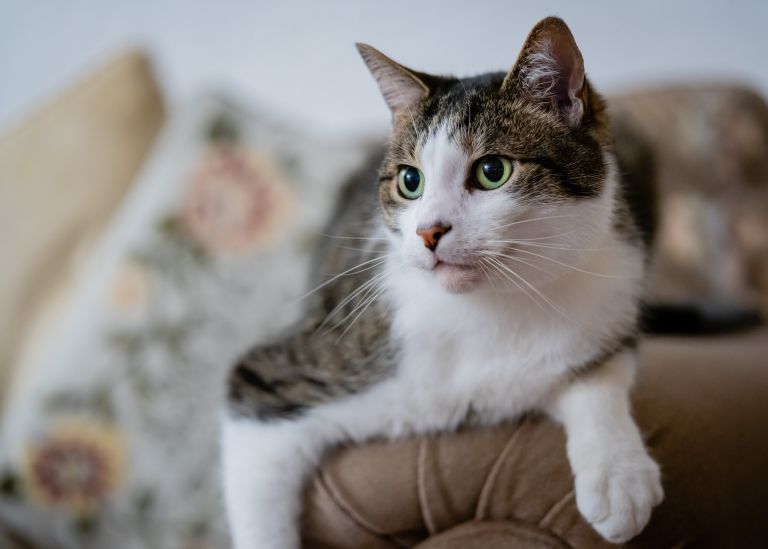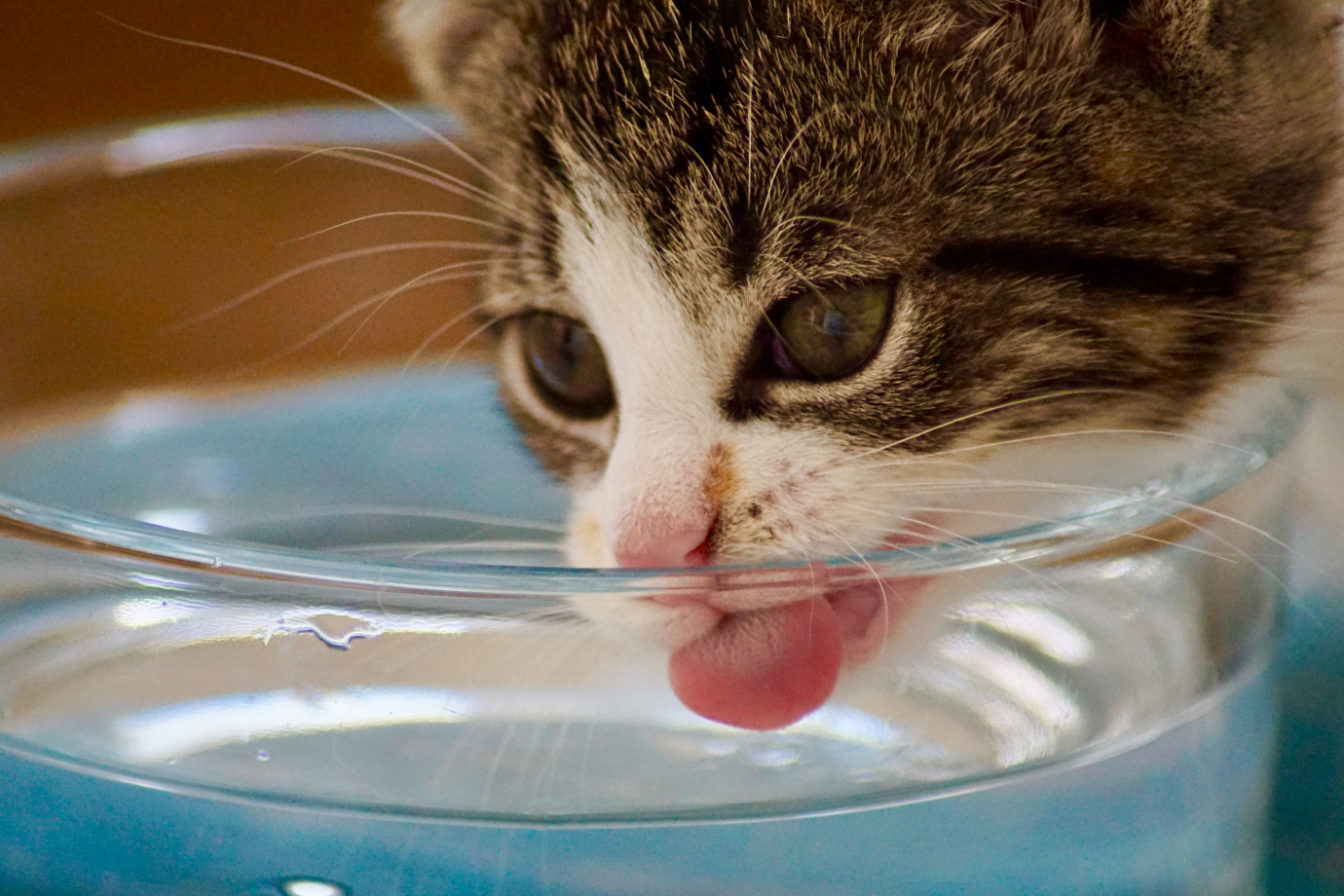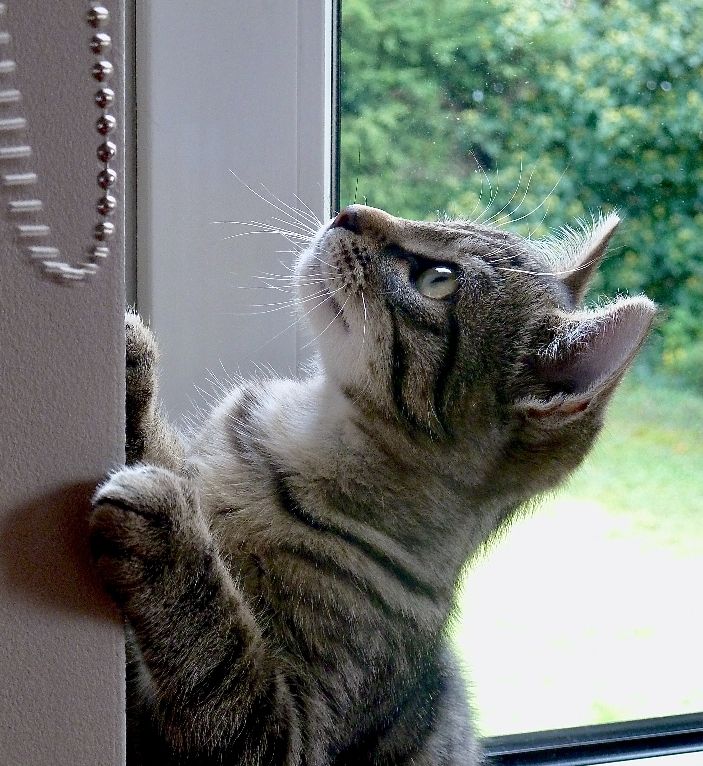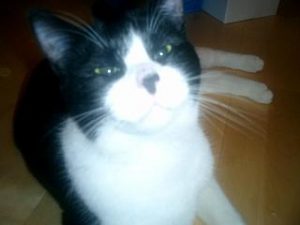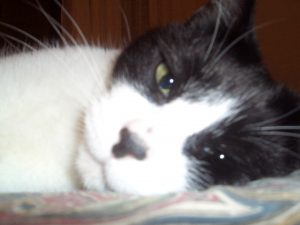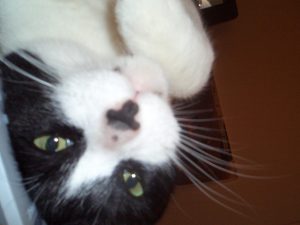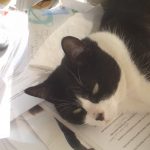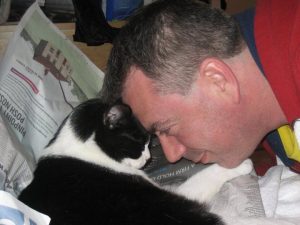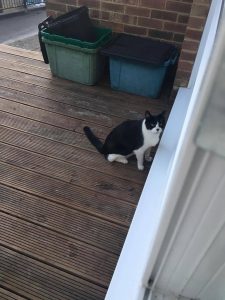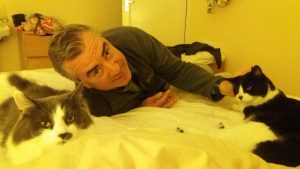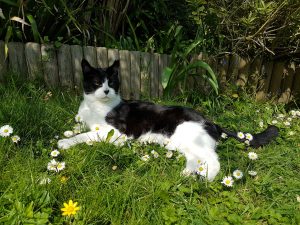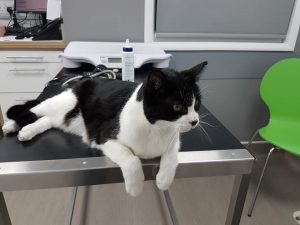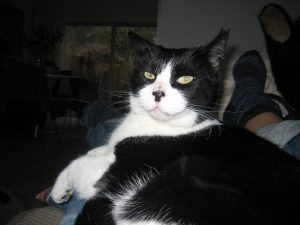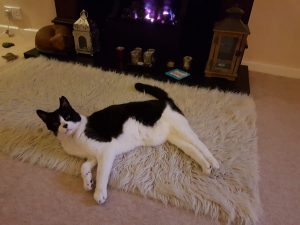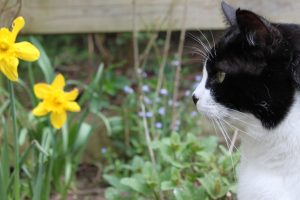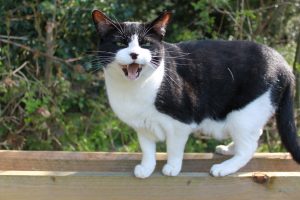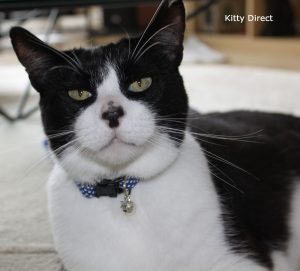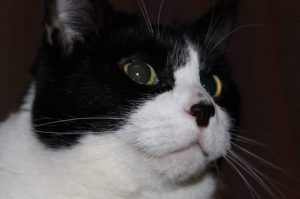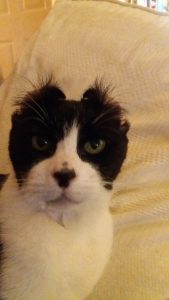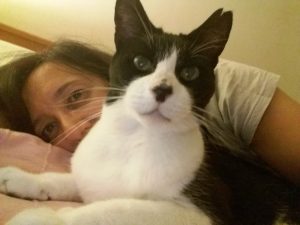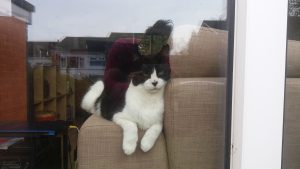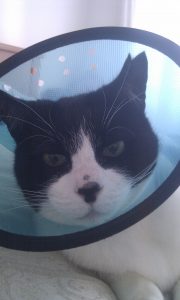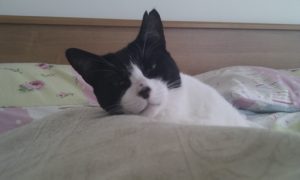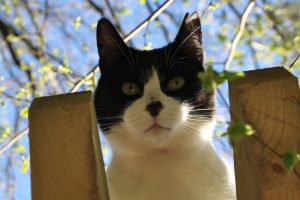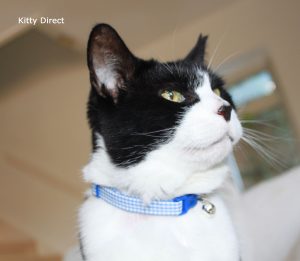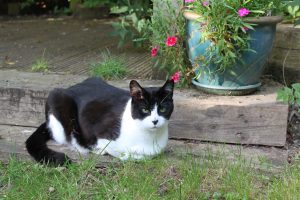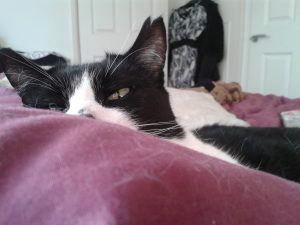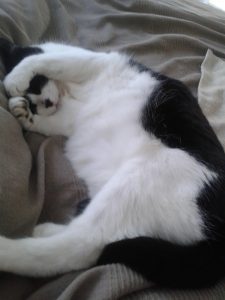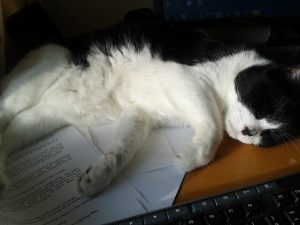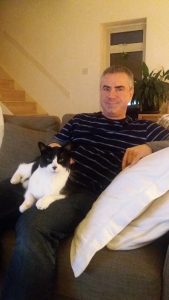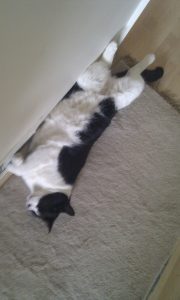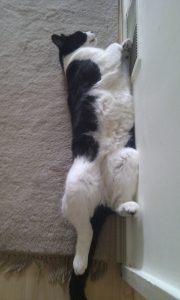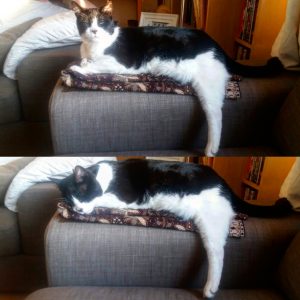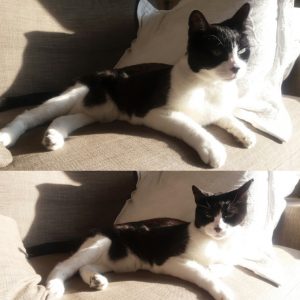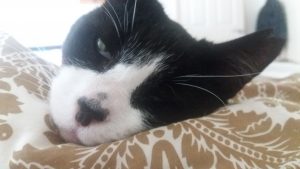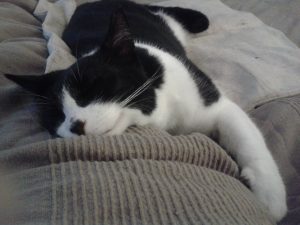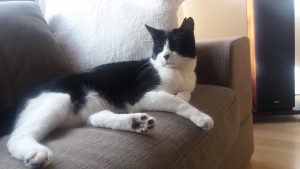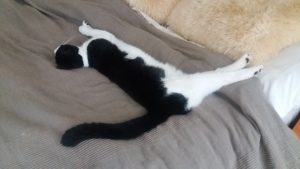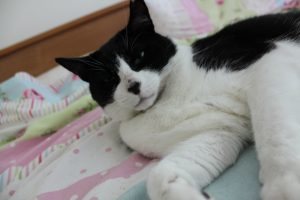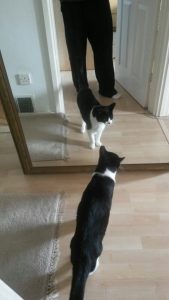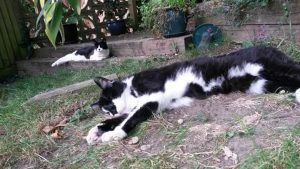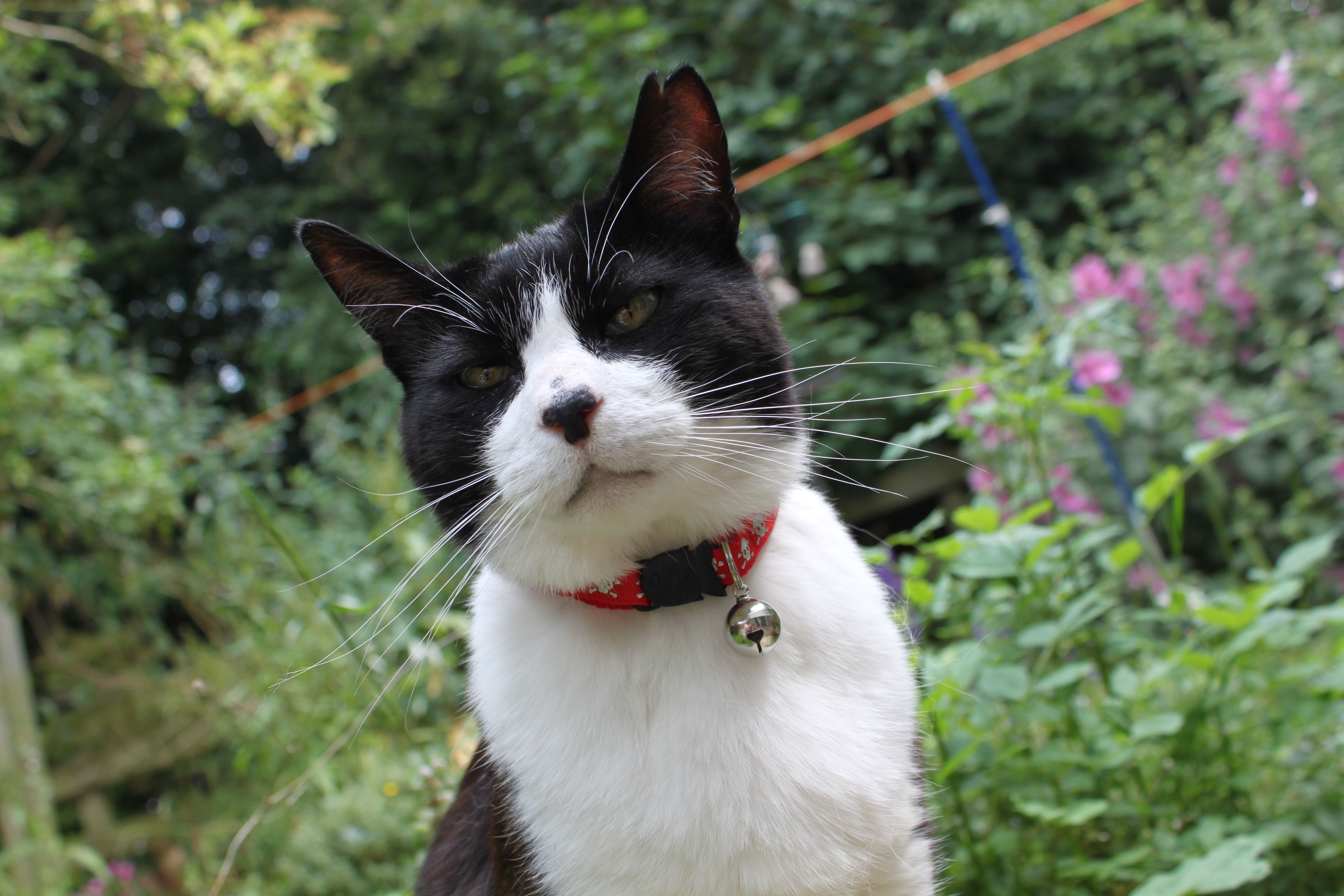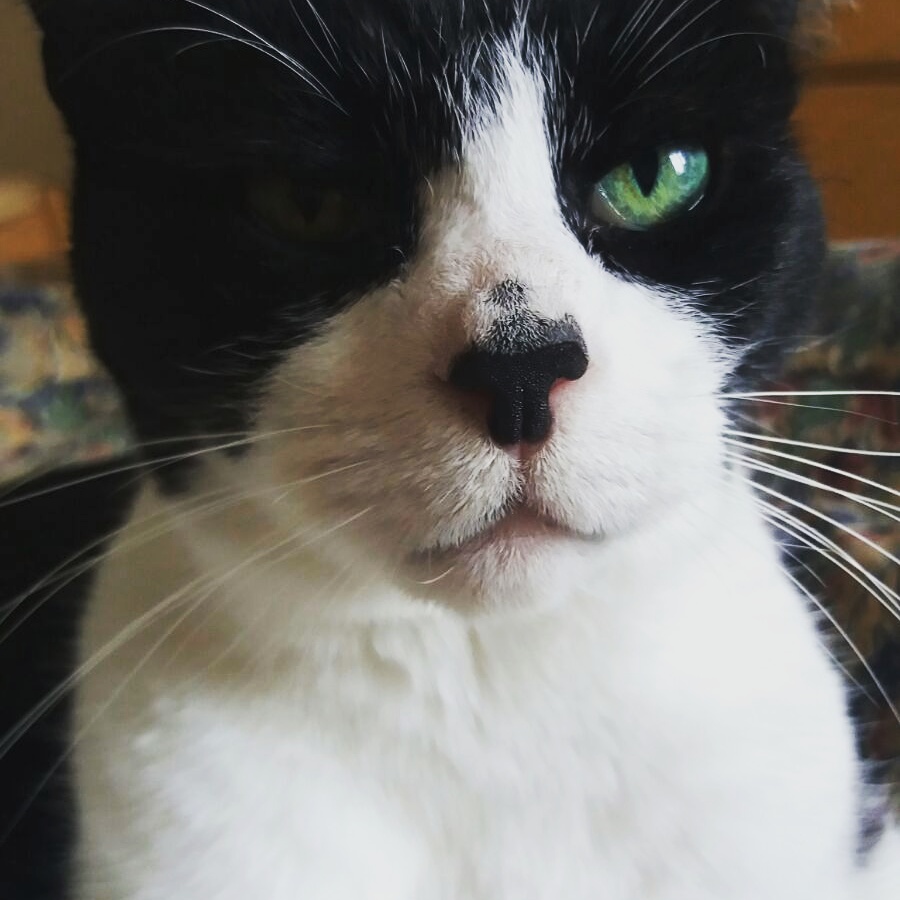
There is so much to tell about Leo, I had to write down his story to celebrate our wonderful boy’s life.
On the 8th April 2020, we took our beautiful boy, Leo, to the vets for the final time. He was a grand age of 20 1/2 years old, which is 98 in cat years. The amazing thing is he still looked like a young cat, a kitty. He looked so young, so serene. The most noticeable thing about Leo was the noble air he had about him. He was bold, stately and possessed almost a regal quality, so much so I called him Prince Leopoldo.
First encounters
I first met him when he was around 6-8 months old, I can’t tell his age for sure as he had been rescued and they didn’t know his exact age. He had been dumped as a kitten on the Brecon Beacons in Wales and was infested with fleas and lice. He had been brought back by Last Chance Animal Rescue to Edenbridge in Kent, because, at that time, Wales euthanised homeless cats and dogs after one week. Hence he had a last chance offered to him by this wonderful charity.
In those days the charity housed all the cats in one `cat house’ where cats lived together until they were rehomed. I was off work and visited there with my sister one Thursday in October; she happened to be a home vetter with the shelter at the time. Of course I took my cat carrier just in case I found a suitable cat….not that I was looking (!) We took a donation of cat food and then wandered round the cat house browsing the cats, chatting to them and stroking the ones that would let us stroke them! There were a few hissers, usually the old ones who were probably fed up of strangers cooing at them and staring at them in the face.
A staff member came in to feed them all. My sister spotted a little black and white kitty running in the opposite direction, amongst this big group of cats. I hadn’t seen him. He was called Corky. Corky didn’t really want to know us, he didn’t come up to us and was skittishly running away. He was grabbed unceremoniously by the tail as it was the only way to get hold of him, and he was given to me. It was then I knew that this little bundle of Corkyness was coming home with me. He was perfect. We put him in the cat carrier and went to the office to sign the adoption documents. Suddenly a name came to me -`Leonardo’. It just flashed in my mind from nowhere and it was so apt for him. So his name became Leonardo Corky.
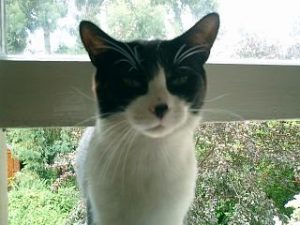
Bringing Leo home where he belonged
He was quiet in the car returning home, his carrier between my feet as my sister drove her two-seater sports car back to my place. I kept peering at him through the bars of the carrier, he was a bit bewildered but calm. I put him in the dining room alone, as I had to introduce him to my other cat, Luca. Luca had been the King Cat for a few months, so I wondered how they would get on. I went back into the room after an hour or so and couldn’t see him anywhere. I looked everywhere, even outside, and thought he had escaped, although I didn’t know how as the doors and window were shut. I was panicking and called my sister. She told me to look under the fire grate.
Sure enough, he was so tiny he had sneaked into the small hole under the Victorian fireplace grate as he must have been scared and overwhelmed. To go from a busy, crowded shelter with many cats to a large, empty room on his own must have been daunting and made him nervous. Bless him.
I remember the next morning I went down to see him and sat down on the floor with my back leaning on the radiator. He climbed onto my knees and started sneezing in my face as he had a cold. He had a cute sneeze, like a squeaky toy. And he was licking my chin area, something he would do for the rest of his life – always in the same place. We had bonded. I had a folding dining table and he would stand or sit under there when my friends and family came in to see him. He was shy and more wary than nervous, which was not surprising considering what he had been through at such a young age. He had travelled from Wales, lived in a communal cat house for a while and competed for food. He wouldn’t run and hide, he would stay somewhere where you couldn’t reach him! Cats are very good at doing that. It was a new world for him, nevertheless he settled in very quickly. He knew he was home and that I was his Mama.
Introducing Leo to Luca
The time came to introduce him to my other cat, Luca. Luca wasn’t impressed, and mostly remained like that with Leo. Although they did get on really, sometimes they would sleep and chill together. Leo was younger and playful. He would lie in front of Luca and start play fighting with him. Luca would just sit there looking down at him and tolerate it for a minute or two. Then suddenly they would be rolling around the floor with Luca really annoyed and miouwing and winning the play fight. They would thump each other with their back legs – no claws involved, thank goodness. Then Leo would start squealing and looking at me to rescue him! I would laugh and say, `You started it!’ They did that often, but it wasn’t real fighting so I wasn’t concerned.
When Leo was released from the dining room after a week, he wanted to sleep with me on the bed and be with me at night. It was Luca’s domain, however, Leo was so insistent and would continually miaouw and yowl loudly outside the door and claw the door until he could come in. This happened for a number of nights. Once I even blockaded the door with a pile of stuff so Leo couldn’t scratch at the door and try to open it. But his incessant miouwing until he got his own way meant that I would inevitably get out of bed and let him in. From then on he was a constant presence at night time, and I would wake up with him next to me with his head on the pillow! Luca didn’t want to share and stopped staying in the bedroom at night which was a shame as he wanted me all to himself.
Leo’s wake-up call
Leo was an extremely vocal cat. For the first two years living with me, he would miouw very loudly at 5 am for food and not stop until I rose out of bed and fulfilled his food need. He used to panic eat quite a lot. He would worry about running out of food and gulp it down quickly. I think it was probably because he went without food when he was dumped so young, and also had to eat his food quickly at the cat shelter, fearing that other cats would take his food.
So every morning I would get up like a barely-awake robot at 5 am to give him his food then go back to sleep. I did that for around 2 years and he grew out of it, but it restarted when he got older and ill.
Leo’s accidents
Leo was a very lucky cat. He didn’t use any of his nine lives. His and Luca’s first home was my first floor Victorian apartment where he and Luca would come and go through the kitchen window, then down the slightly sloped roof, then onto the top of the fence then jumped down into the garden. That was their cat route. When I was out at work they would either be inside or outside and then come and go as they pleased when I was at home. There was a greenhouse in the garden below the kitchen window. It had a broken roof window and Luca had jumped down through the hole and had managed to exit without cutting himself. Leo, because he was younger and copying Luca to learn, copied Luca jumping into the greenhouse, but unfortunately cut his paw pad badly on the broken glass inside on the floor. I panicked and took him to a Sunday emergency vet in Streatham. He was absolutely fine.
Another time I was painting my flat just after I brought him home and he accidentally tipped a bottle of white spirit all over him when he was jumping around and exploring the kitchen. I immediately scooped him up, before he could lick himself clean, and put him in a bath of warm water and scrubbed and rubbed him for a good 20 minutes to get rid of the poisonous fluid on him. He didn’t like it and looked like a skinny, wet rat, but it was for his own good!
Apart from a slit ear through a fight with a persistent cat who occupied our garden, he was fit and healthy and didn’t suffer anything serious or accidental after that.
Leo Love
I have a phrase that I use: Leo Love. Because he really gave a lot of love. He had a lot of love inside of him and he showed dedicated love throughout his life. He came into my life when I didn’t have a lot of love, and didn’t feel very loved, although I had friends and family around me. And he showed me love and gave me love, which is exactly what I needed. He also showed me how to love, and I recognise that we both needed each other and we were together and connected for a reason. I will always be grateful to him for showing me such love and being a loving soul in my life. I kind of believe in reincarnation and perhaps our souls have always known each other and been connected in another life. That is how it feels.
Leo in life
Leo lived a very happy, fulfilled and peaceful life. In the early years with me when I was in my 30’s, I had a busy and social life, commuting to and working in London, long hours and going out with friends. He would be part of my parties at home with friends and family and took it all in his stride. I then worked from home for a number of years so I was lucky enough to spend a lot of time with my fur babies. Leo would be on my desk during the day. Luca would be there from 5 pm, before his dinner. They both had their desk routine!
Over 20 years he moved three times with me and when my partner, Mark, arrived on the scene he loved Mark dearly and Mark loved him. Mark was his Big Papa for 9 years. They were Big Papa and Little Papa. Leo was a huge part of our life throughout all the changes, ups and downs that life throws at you.
He would chill with us and our other cats in the living room in the evenings, and later in life, in front of the fire, just where he should be. He was like a Christmas card picture, him settled in front of the roaring fire. I would say he was warming his furry bones.
He had beautiful, smooth glossy fur, especially his white fur at the front was a beautiful, clean white. He would groom and keep himself clean. He had gorgeous green eyes, a bobble on the end of his tail and club-shaped paws. He had a lovely little black nose surrounded by white fuzz and with a small dot above it. He was a heavy and solid cat, probably because of the amount of food he ate, and a swinging furry tummy that never decreased in all his life. Our lovely vet, Phillip, said his bobble at the end of his tail was maybe because he was the runt of the litter and it had got squashed, so his delicate, kitten tail became slightly deformed. But we loved his special tail.
He was loyal and very close to me, like my attachment, and that happened from day two of bringing him home. He would love to rest his back leg on me when he was chilling, he loved me stroking him and was calm and still. I would take him up the stairs swinging him from side to side saying `swoop, swoop` as though he was flying through the air. He would hang around the bathroom. His tail was always upright in a straight, vertical line and when he jumped up, he would do it stylishly, crossing his legs in a sassy way and with a miouw. His hind legs were dainty and perfectly formed, and I called them his `chicken legs’. He would cross them regally.
He would lie with us or the other cats on the sofa, lie on my outstretched legs and just make himself comfortable. He was very good at stretching out and making himself comfortable, his back leg hanging down. I would turn his ears inside out. I couldn’t help myself as they used to stay inside out, the other cats’ ears didn’t. He would just let me do it and look at me as if to say, “Here we go again.” He would be still and let me pull him towards me and cuddle up lengthwise up against my arm or leg, a perfect fit. He would `surf’ against the heating vents and lie there getting nice and warm with the hot air. He would tolerate being picked up for probably one minute, then want to be put down. I would sometimes dance with him for about one minute before he had enough.
He had a very loud calling miouw, along with silent miouws and chirrups, and sometimes he would shake his head quickly, open his eyes wide looking at me and miouw, as though he was trying to tell me something. His little miouwing face would appear at the back door to be let in.
Leo’s pet names
I know I am not alone when I say pets pick up other pet names through their lives. Leo’s full name was Leonardo Corky. Leo because of my Italian heritage. His other main name was Boyo from a young age, because he came from Wales. Mark and I added to his names over the years. Prince Leopoldo because of his regal air. He even had his own cushion on the bed that I called his `throne’ as he loved to lie on it for years, until he became older and didn’t lie on it. I still have it on the bed. His other names are Bert (pub name), Paco (Spanish name), Pyewacket (witches’ cat name) and Little Papa. His military name was Private Corky as he would patrol the perimeter of the garden every night to warn off other cats.
Leo’s mouse game
He couldn’t really play well, he wasn’t co-ordinated enough. He would swipe at pieces of string or feather toys and bang his paw on the ground indiscriminately. I should have played with him a lot more to teach him co-ordination. He did play a game as a kitty though. He was very clever with this game. I would shake a toy mouse that rattled, say `mousey’ then throw it. Then Leo would run after the mouse, pick it up and put it somewhere for me to find! Then I would find it, pick it up, throw it and he would take it and put it somewhere else. How clever was he! He grew out of that game. I tried to reconvene his game a few years later but I think he had forgotten it or wasn’t as keen to play.
Leo’s food
Leo loved his food, although he would panic eat from time to time. He didn’t have to, he had plenty of food and treats throughout his life. His favourite human foods were prawns, tuna, steak, chicken curry, raw beef mince. He absolutely loved his food and would sometimes sit there for a morsel or two at dinner time. We would chill together on a Saturday night and I would make a lovely dinner for myself, steak or curry. And we would share it, me feeding him and Luca tasty morsels. I have fond memories of those Saturday and Sunday evenings that we shared together. He became known as `Beefy Boy’ because of his love for steak and mince!
Leo’s social side
Leo was a social cat indeed. From a shy and wary cat, he became a social and friendly boy. He wasn’t a nervous cat, he had an underlying courage and stoicism. He would greet visitors coolly and casually. He knew who he liked. He would make himself at home on Mark’s mum’s knees when she visited, and he loved her making a fuss of him. He’d come and say hello to Mark’s dad, my mum and dad and visitors. He would go for an early evening walk and sit under the street light by the next row of houses. He would then stroll to my neighbour, Mel’s, French windows and sit looking at Popsy, her cat. They would make noises at each other and have a chat. Popsy passed and I like to think that they are taking a stroll with each other in the early evening, at around 7 pm.
I remember, when he was a kitty and first with me, my neighbour told me that he would sit on their patio and come into their kitchen during the day. At the time I was surprised as he was wary, but now I can see him doing that as he was cool and sociable.
Leo’s lack of hunting skills
As every cat owner knows, your cat is probably going to bring in prey, dead or alive. Leo didn’t have honed hunting skills, like Luca or Dolly has. I remember hearing a faint cheeping under the bed one warm afternoon and, looking underneath, saw a beautiful baby robin bird. It was just sitting there. Leo had brought it in and luckily it had survived, his teeth hadn’t harmed the bird at all. I stretched underneath the bed, gently held the robin and put it in a shoe box with holes in it.
I drove to our local wildlife hospital, 30 minutes away, looking at this robin who was looking at me from the box on the front car seat. I had opened the box in the car as the bird was still and seemed quite happy to just sit there. It was quite a surreal but lovely experience. The bird was checked out by the hospital and successfully released. So much for Leo’s hunting ability!
Leo and Dolly
We adopted our beautiful Dolly when she was five months old. We had been looking for a kitten and luckily Dolly was available for rehoming via a friend. At first, we separated her from Luca, Leo and Alfie for two weeks so we could introduce them gradually. When we gave Leo a preview, he came into the room, looked at her and immediately chased her, as she looked like a little ferret running from him and just like prey! We didn’t think it was going to go well and Leo was going to accept her. But how wrong we were. They became buddies and friends, sharing the beds and sleeping together like two furry bed mates. Very often I would have one each side of my legs snuggled right up against me so I couldn’t move! They would chill together in the garden and Dolly loved Leo very much. She would always want to be near him and reach out to play with him or swipe him, and he was very calm with her. Occasionally Leo would groom her tail and got a mouthful of fluff.
Leo’s health
Leo’s health was excellent through his life. The only thing that Leo suffered with was his poor teeth. He had really bad teeth and gums which must have been painful for him throughout his life. He had a tooth extraction and one tooth came out at the vets. I tried to brush his teeth with cat toothpaste but it didn’t work. He didn’t eat much dry food which helps with descaling cats’ teeth. The kibble would fly out of the side of his mouth through his teeth gaps, so that didn’t help his dental health. It was funny when food flew out from his mouth. He would tend to suck in his food rather than eat it with his teeth and chew; just like a hoover!
Leo had a funny and cute twitch. He would twitch his head backwards suddenly and blink. It started to happen when he was around 12. The vet said it was neurological and nothing to worry about.
When he was around 17 1/2 he developed hyperthyroidism which is quite common in cats. The vets spent months trying to ascertain the right dosage for him. He started to eat more and was on medication for the rest of his life. One thing with giving Leo’s medication – he always managed to avoid it in his food! He just would not eat the patch of food that had the meds `hidden’ in it. He was way too smart for that. So any meds I would have to give to him orally, which meant me unceremoniously tilting his head back and popping the tablet or liquid into the back of his throat. It was the only way to medicate him.
We moved to the South Coast in 2018 to the beautiful house we live in now. He made the most of our house and he mainly stayed in the bedroom lying on the bed. He was happy and comfortable. Luckily our vet, Phillip, found the right dosage for him after months of trials and blood tests. But Phillip found another problem, a growth or mass internally. Leo went for a scan and his kidneys were enlarging and there was a lump. We had the choice of surgery to find out what it was, but because of his age we decided not to put him through that. Phillip said that was fine, and he wouldn’t know about it anyway.
Leo was with us for another 18 months, which is amazing. His health did deteriorate over time, but not drastically so. His hyperthyroidism remained stable, however in time his kidneys weren’t functioning well. I would often wonder how much longer we had with him, and we are so grateful for the two Christmases we spent together.
He would lay on the bed all day and night with the exception of getting up for food and to go outside to toilet. That was his daily routine. Mark would escort him outside, even at 10 pm, midnight or 5 am. He started to yowl 2-3 times a night for food, so our sleep was broken and we had to bring his bowl and cat food into our bedroom in the end so that Leo and we didn’t have to keep going downstairs to feed him. It was like having a baby. He would then eat, go outside on the landing and yowl then come back onto the bed. He found it difficult using the cat flap with his arthritic limbs, but sometimes he would slip out of the cat flap at 5 am, yowl outside to come in or then come inside and yowl very loudly. He was so loud when he yowled, like a baby crying, and even our neighbours heard him! Mark said when he came back in from outside and yowled, he was announcing his arrival.
He had dementia too, so he would forget he had food, and a full food bowl, and cry for more. The vet said we could give him treatment for his dementia, but we didn’t like the thought of giving him more drugs, and he seemed happy enough. We think he was deaf as his ears stopped twitching and turning round for sounds and he wouldn’t hear us come in or speak to him. He always looked surprised if we crept up on him! I would say Boyo in my voice to him near his ears and onto his head so he could feel the vibration. He would also drink a lot and regularly because of his kidneys; there was always a full glass by the bed. He would position himself and his legs to drink it, sometimes clawing the bedside table to stabilise himself as he leaned forward slightly with straight legs. I put the glass on a book so it was the right height for him to drink from. I did try the glass of water on the floor, but he wouldn’t drink from it on the floor! Not once did he knock or spill this glass that teetered on the side of the table on a book. Not once. In fact, the night before we went to the vets for the final time, I brushed the glass and spilled it! I thought, how ironic. He was a clever boy.
Occasionally he would go outside into the garden and stay in the sun for a while, but not for as long as he used to. When we lived in our second home he loved to be outside in the garden that backed onto woods and our cats could freely roam around. It was heaven for them. He would lie on the large, bottom step of our wooden pergola or the broad sleeper in the raised bed, or under a shrub bush with our other cat, Dolly. Those were his favourite garden spots. When he went into our current garden, Dolly would run towards him and lift her paws; she wanted to play. But Leo was past playing and any over-physical activity and simply plodded on through the garden. He wasn’t allowed in our front garden because we didn’t want him to escape onto the street and get lost. It was such a shame as it is lovely and quite large and he would have loved it if he had got to know the area better.
Leo was still physically good in later years, although he was stiff. He half-jumped down the stairs in bunny hops and slowly and methodically made his way up them. He would jump on the bed in a two-step approach. After he passed I found his small claw marks under the covers on the bed frame where he would get a grip with his back legs to push himself up.
Leo’s passing
The end came when Leo only ate a small amount of his food. It happened really quickly, over 2-3 days at the weekend. We knew that something was wrong as Leo never left his food uneaten, he was listless and he had an infected smell about him. We also knew because he did not want to toilet outside, looking inside for somewhere to go. That was another big sign as he was so steadfast and fastidious about doing his business routine. So I took him to the vet on Tuesday 7th April and it was sad news. The blood test had revealed his kidneys were off the scale and could not process the toxins in his blood and body. He had lost a kilo in weight. We had two choices: the vets rehydrate him for two days or put him to sleep. Phillip, our vet, said the rehydration treatment may not work, or it may take longer. Because of his age, we didn’t want to put him through that, and it was a temporary measure anyway, as his kidneys were not good. So we made the sad and traumatising decision. It had to be within 24 hours because he was going to get worse and it wasn’t fair on him. The additional pressure was that the kind vet whom he knew was on leave the day after, and we wanted Phillip to be with him.
That last night with him was so awful. I woke up in the middle of the night with a heavy and dark feeling. He didn’t want food at 3 am which was not like him at all. To know that you are putting your beloved pet to sleep, and they don’t know and you can’t tell them, is the worse thing. To know that you have a finite number of hours left after all your years together is heartbreaking. It was like an invisible countdown clock ticking away, looming ever nearer with each second and minute. I understand the Grim Reaper now. We made the appointment at 5 pm on Wednesday 8th April, the latest time so that we could spend the day with him. He was very still on the bed. We spoiled him with his favourite foods, mince beef and tuna, and even then he couldn’t finish it. I hand fed him some of it. We talked to him and cuddled him. I photographed and video’d him a last message telling him how much we loved him and to come back and see us.
His beautiful green eyes looked at me. It was like he was there in body, but not in spirit. He was disinterested and a shell of his former self. His skin had started to sag and his tail fur was looking bedraggled. But the strange thing is he looked well until the end, he didn’t look sick, weak or ill. His fur was beautiful and smooth and his face looked the same as it always did. I felt sick as I cut small chunks of his fur so I could keep a part of him.
He spent 20 minutes in the garden. The sun was shining and it was quite warm. It was lovely to see him sunning himself on his favourite spot on the patio and settle in the shade. He shut his eyes in the sun and sniffed the air. It was almost as though he was having a last moment in the garden and in the sunshine, feeling warmth and light on his furry bones. We took him to the front garden where He got into there once and I had to chase him to take him back through the side gate and into the back garden. But he wasn’t really interested, had enough and we took him inside.
Because of this wretched coronavirus situation, we couldn’t be with him and hold him until the end. We would have chosen to have him go to sleep at our home, however that choice was taken away from us. So we were comforted that Phillip would be putting him to sleep. Phillip had been his vet since we moved and he was kind and gentle with Leo and Leo felt comfortable with him. It was the worst thing going to the vets in the car. There were many tears and I held him on my lap, holding his head to steady him, as he disliked being in the cat carrier. At the vets, he was miouwing loudly as he wasn’t feeling good and hated the travelling. We put him in the cat carrier and set him down and he was still miouwing and unhappy. We spoke to Phillip through the window and I was bawling my eyes out. It was horrible. We said goodbye to Leo for the final time. Mark had picked and placed our garden primroses into his carrier so he had a bit of the garden with him. The last I saw of him was him miouwing on the concrete ground in his carrier, next to the vet nurse. It wasn’t dignified enough for Leo, he deserved far better than this.
The vet said they could sedate him and bring him out and we could have our last moments in the car with him. But that, again, wasn’t dignified enough for our Leo. We had said our goodbyes and we left distraught and in tears.
It should have been us carrying him in and being with him to the last second of his life on earth, but that couldn’t be and we were resigned to that. It is strange because I, like every pet owner, dreaded those last final moments with Leo. However, I have been told by an animal welfare expert that it is the best thing you can do for your pet, to be with them at the end. And that will always hurt us knowing that. But in a way, because I dreaded it so much and had thought about it for many years before, maybe Leo had a hand in that. Because he was stoic and brave and he would have been fine.
He had been so stoic and beautiful right until the end. What a clever and amazing boy he was.
Leo’s signs
We came back and sat in the garden in the late afternoon sun and talked about Leo knowing the deed was probably done by then. We both felt numb. Then Mark went upstairs to his office for 10 minutes and came back to the garden. He said that a small bird had flown to the window, landed on a broadband cable that hung outside the window and had looked straight at him, then flew back to the laurel bush. I was watching the bird flit backwards and forwards in the garden. The bird did this four or five times, and it hasn’t happened before or since. We believe it is a sign from Leo that he is free.
During the days after, I felt a brush of his fur on my finger in bed and heard his claws scratching on the bedside table as they did when he drunk his water from his glass. Mark sees flashes of a moving shadow from the corner of his eye, and we have experienced that with Luca who passed in 2016. They say that your pets come back with signs, and Leo has come back. We believe he and Luca are all around us, and we talk to them all the time.
I miss Leo terribly, we both do. Mostly when I wake up and go to bed as he was always with me on the bed. I reach out to stroke his lovely, furry body and solid ears and he isn’t there. He leaves an emptiness that you cannot fill ever again. Our Dolly missed him for the first week, she didn’t eat and was looking for him. She looked lost and sad. Alfie, our other cat, couldn’t care less! We have left his food bowl and mat where it is and his medicine spoon unwashed.
Life’s full circle
The day before he passed, I gave him a bath because his fur was in poor condition and it needed it as he had stopped grooming himself. I wanted him to be clean again and didn’t want him to go to the Rainbow Bridge with mucky fur. It was like he was a tiny kitten again with me washing the white spirit off him in the bath with warm water. It is strange how life can be a full circle and repeats itself. Of course he didn’t like it, like the first time, and I dried him off with my hairdryer on a low heat, and he sat in the afternoon sun.
For the last three months he had a cold and was sneezing. When I first brought him home from the animal sanctuary, he had a cold. He would sneeze exactly the same as when he was a little kitty, like a squeaky toy and so cutely. That sneezing was our bonding on our first day together, and it was part of our last weeks too. He gave me a weak lick on the chin on his last day, just like he did on the first day of our lives together, albeit his kitty lick was a lot more energetic.
I had been ill with bad viruses three times and had surgery on my foot. When I was sick and bed-ridden, Leo had always been there by my side, lying with me in bed and being a significant comfort to me. I had hoped that Mark and I had done the same for him when he needed us and his health was failing.
Leo Loss
When you lose a pet, some people may think `so what, it’s only a cat.’ But pet bereavement is a very real and valid experience to go through, as a pet is part of your family. They give you unconditional love and are always with you, through every moment, life phases and changes, sharing your life for many years. So when Leo passed, it left a huge black and white, furry hole in our lives. We miss his traits, quirks and characteristics. We miss his yowling and sounds, we miss talking to him and his gentle and calm ways. Most of all we miss his physical presence in our family and home. It is remarkable how much that presence is missed and deprived from you, because he was always with us.
In the first few days I felt anxiety and a panic at the thoughts I would never see him again or touch or stroke him. We collated and looked through all of our photos and videos of him and we have hundreds, so that gave some comfort, although it isn’t the same of course.
Leo was stoic to the very end and we will always love him. He is always in our hearts, with Luca, and is always a part of our family. We will come to celebrate him more when the pain subsides, but the grief is always there. It comes in pangs and waves, creeping up and overtaking your emotions and thoughts. Then it goes, then it comes. You learn to accept death, but you never get over it. You live with it.
We know that Leo is in a `better place’ as they say. Phillip, our vet, sent a lovely card saying that we did the right thing and it stopped him suffering. He said that Leo’s end had been peaceful, he hadn’t struggled or shown distress. That gave me great comfort because you always wonder. Was it too soon, was it too late, did I do the right thing? I joined pet bereavement Facebook Groups after Leo’s death to make sense of it and be part of an empathetic group who understands what you are going through, because we are all going through the same emotions and thoughts. And guilt comes up time and again. You question your actions and the impact it has on your pet. I wanted to have him for another week, but that was my selfishness taking over, and to make that huge decision on Leo’s final end within 24 hours seemed rushed. But it was the right choice for Leo, because he was not going to get any better. He deserved his dignity. We have to do what is right for our pet, rather than what is right for us as their guardian. We believe that it was Leo’s time and that was what Leo wanted.
Leo’s ashes arrived a week later in a box. Strangely, the box has a shadowy, sunlit woodland image on it, similar to the woods that he used to wander through for 15 years. I peered inside and was fascinated that it was Leo. The dust and ashes, the finality of it all in a small plastic bag, in a box. But I know Leo is not in that box. He is a free spirit, a young kitty again without suffering and pain. And it brings tears to my eyes to write this tribute, but I know he will always be our Leo and around us. He is free like a bright, beautiful butterfly emerged from a cocoon, in the sunlight, happy and vibrant. That is all that matters for our beautiful Boyo, and what he deserves.
We love you, Boyo. And we miss you terribly. When the primroses come out every year we will think of you in the garden, in the sun. Thank you for being such an important and special part of our lives. All our love forever, and ever.
